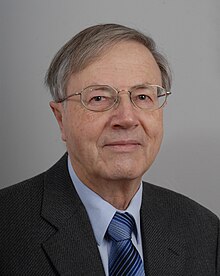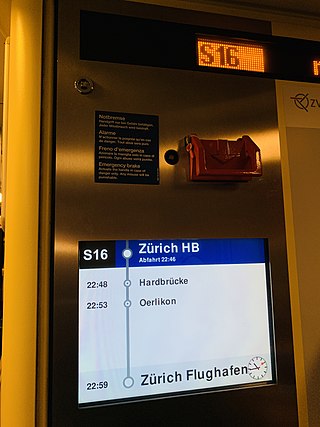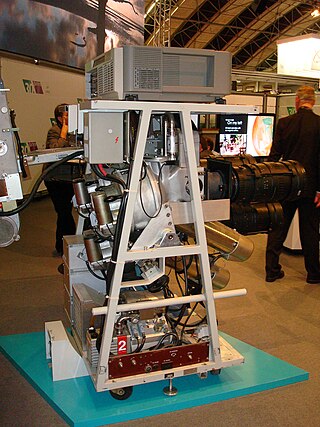Peter J. Wild (born 1939) is a Swiss electronics engineer and a pioneer of liquid-crystal display (LCD) technology.
Contents

Peter J. Wild (born 1939) is a Swiss electronics engineer and a pioneer of liquid-crystal display (LCD) technology.

Peter Josef Wild was born and educated in St. Gallen, Switzerland. He studied electrical engineering at the Swiss Federal Institute of Technology in Zurich (ETH Zurich) and graduated in 1963. [1]
From 1965 to 1968 he worked in the San Francisco Bay Area, California, as development engineer and obtained a Master of Science degree from the Department of Electrical Engineering and Computer Science at UC Berkeley. After his return to Switzerland in 1969, he joined the new Corporate Research Center of Brown, Boveri & Cie (now ABB) in Baden, Switzerland, developed a phase measurement for an opto-electric current meter on high-voltage lines based on the Faraday effect working with Andre Jaecklin and became the first member of a team developing LCDs from 1970 onwards. [2]
In 1980, he started working in the Swiss telecommunications industry for the rest of his career. [1]
Initially, Wild investigated earlier LCD work done at the RCA Laboratories in the US. Thereafter, Brown Boveri entered into a joint venture with Roche in Basel to explore LCD technologies. As part of this common project, physicists at Roche discovered and patented the Twisted nematic field effect (TN). Also, new room-temperature liquid crystal compounds for the TN effect were developed during this cooperation. [3]
Wild recognized early-on, that matrix-addressing of such displays was important for many potential applications to show images (such as flat-screen computer monitors). Results of his work in this field were published. [4] [5] [6] In particular, Wild discovered, that the RMS voltage of the driving waveforms of LCD matrix displays is relevant for the electrooptic threshold and is not to be exceeded at partially-addressed pixels of passive-matrix displays. [7]
Pioneering work of his team included experiments with LCD projectors [7] [8] [9] as well as illumination schemes for backlit panels resulting in corresponding patents. [10] More than 20 patent applications where filed naming Wild as inventor or co-inventor. [11]
He helped setting up manufacturing of TN LCDs at a new factory in Lenzburg, Switzerland, which started deliveries in 1974, mainly to manufacturers of digital watches, [12] such as Casio of Japan, which used these LCDs to launch its first quartz wristwatches with digital time display under the Casiotron brand. [2]

A liquid-crystal display (LCD) is a flat-panel display or other electronically modulated optical device that uses the light-modulating properties of liquid crystals combined with polarizers. Liquid crystals do not emit light directly but instead use a backlight or reflector to produce images in color or monochrome. LCDs are available to display arbitrary images or fixed images with low information content, which can be displayed or hidden. For instance: preset words, digits, and seven-segment displays, as in a digital clock, are all good examples of devices with these displays. They use the same basic technology, except that arbitrary images are made from a matrix of small pixels, while other displays have larger elements. LCDs can either be normally on (positive) or off (negative), depending on the polarizer arrangement. For example, a character positive LCD with a backlight will have black lettering on a background that is the color of the backlight, and a character negative LCD will have a black background with the letters being of the same color as the backlight. Optical filters are added to white on blue LCDs to give them their characteristic appearance.

A watch is a portable timepiece intended to be carried or worn by a person. It is designed to keep a consistent movement despite the motions caused by the person's activities. A wristwatch is designed to be worn around the wrist, attached by a watch strap or other type of bracelet, including metal bands, leather straps or any other kind of bracelet. A pocket watch is designed for a person to carry in a pocket, often attached to a chain.
An active-matrix liquid-crystal display (AMLCD) is a type of flat-panel display, the only viable technology for high-resolution TVs, computer monitors, notebook computers, tablet computers and smartphones with an LCD screen, due to low weight, very good image quality, wide color gamut and response time.
A thin-film transistor (TFT) is a special type of field-effect transistor (FET) where the transistor is thin relative to the plane of the device. TFTs are grown on a supporting substrate. A common substrate is glass, because the traditional application of TFTs is in liquid-crystal displays (LCDs). This differs from the conventional bulk metal oxide field effect transistor (MOSFET), where the semiconductor material typically is the substrate, such as a silicon wafer.

A flat-panel display (FPD) is an electronic display used to display visual content such as text or images. It is present in consumer, medical, transportation, and industrial equipment.

An LCD projector is a type of video projector for displaying video, images or computer data on a screen or other flat surface. It is a modern equivalent of the slide projector or overhead projector. To display images, LCD projectors typically send light from a metal-halide lamp through a prism or series of dichroic filters that separates light to three polysilicon panels – one each for the red, green and blue components of the video signal. As polarized light passes through the panels, individual pixels can be opened to allow light to pass or closed to block the light. The combination of open and closed pixels can produce a wide range of colors and shades in the projected image.

A backlight is a form of illumination used in liquid crystal displays (LCDs). As LCDs do not produce light by themselves—unlike, for example, cathode ray tube (CRT), plasma (PDP) or OLED displays—they need illumination to produce a visible image. Backlights illuminate the LCD from the side or back of the display panel, unlike frontlights, which are placed in front of the LCD. Backlights are used in small displays to increase readability in low light conditions such as in wristwatches, and are used in smart phones, computer displays and LCD televisions to produce light in a manner similar to a CRT display. A review of some early backlighting schemes for LCDs is given in a report Engineering and Technology History by Peter J. Wild.
A thin-film-transistor liquid-crystal display is a variant of a liquid-crystal display that uses thin-film-transistor technology to improve image qualities such as addressability and contrast. A TFT LCD is an active matrix LCD, in contrast to passive matrix LCDs or simple, direct-driven LCDs with a few segments.

An Eidophor was a video projector used to create theater-sized images from an analog video signal. The name Eidophor is derived from the Greek word-roots eido and phor meaning 'image' and 'bearer' (carrier). Its basic technology was the use of electrostatic charges to deform an oil surface.

A super-twisted nematic display (STN) is a type of monochrome passive-matrix liquid crystal display (LCD).

The twisted nematic effect (TN-effect) was a main technology breakthrough that made LCDs practical. Unlike earlier displays, TN-cells did not require a current to flow for operation and used low operating voltages suitable for use with batteries. The introduction of TN-effect displays led to their rapid expansion in the display field, quickly pushing out other common technologies like monolithic LEDs and CRTs for most electronics. By the 1990s, TN-effect LCDs were largely universal in portable electronics, although since then, many applications of LCDs adopted alternatives to the TN-effect such as in-plane switching (IPS) or vertical alignment (VA).

A transflective liquid-crystal display is a liquid-crystal display (LCD) with an optical layer that reflects and transmits light. Under bright illumination the display acts mainly as a reflective display with the contrast being constant with illuminance. However, under dim and dark ambient situations the light from a backlight is transmitted through the transflective layer to provide light for the display. The transflective layer is called a transflector. It is typically made from a sheet polymer. It is similar to a one-way mirror but is not specular.

Martin Schadt is a Swiss physicist and inventor.

Large-screen television technology developed rapidly in the late 1990s and 2000s. Prior to the development of thin-screen technologies, rear-projection television was standard for larger displays, and jumbotron, a non-projection video display technology, was used at stadiums and concerts. Various thin-screen technologies are being developed, but only liquid crystal display (LCD), plasma display (PDP) and Digital Light Processing (DLP) have been publicly released. Recent technologies like organic light-emitting diode (OLED) as well as not-yet-released technologies like surface-conduction electron-emitter display (SED) or field emission display (FED) are in development to replace earlier flat-screen technologies in picture quality.

Fritz Fischer was a technical physicist, engineer and inventor. He was married to Maud Schätti.
Electrically operated display devices have developed from electromechanical systems for display of text, up to all-electronic devices capable of full-motion 3D color graphic displays. Electromagnetic devices, using a solenoid coil to control a visible flag or flap, were the earliest type, and were used for text displays such as stock market prices and arrival/departure display times. The cathode ray tube was the workhorse of text and video display technology for several decades until being displaced by plasma, liquid crystal (LCD), and solid-state devices such as thin-film transistors (TFTs), LEDs and OLEDs. With the advent of metal–oxide–semiconductor field-effect transistors (MOSFETs), integrated circuit (IC) chips, microprocessors, and microelectronic devices, many more individual picture elements ("pixels") could be incorporated into one display device, allowing graphic displays and video.
IPS is a screen technology for liquid-crystal displays (LCDs). In IPS, a layer of liquid crystals is sandwiched between two glass surfaces. The liquid crystal molecules are aligned parallel to those surfaces in predetermined directions (in-plane). The molecules are reoriented by an applied electric field, whilst remaining essentially parallel to the surfaces to produce an image. It was designed to solve the strong viewing angle dependence and low-quality color reproduction of the twisted nematic field effect (TN) matrix LCDs prevalent in the late 1980s.

T. P. "Peter" Brody was a British-naturalised physicist and the co-inventor of Active Matrix Thin-Film Transistor display technology together with Fang-Chen Luo, having produced the world's first Active Matrix Liquid Crystal Display (AM-LCD) in 1972 and the first functional AM-EL in 1973 while employed by Westinghouse Electric Corporation in Pittsburgh. Brody coined the term "active matrix" and first used it in a published journal article in 1975.

Gustav Guanella was a Swiss inventor who held numerous patents.

Guest Host Displays, Dichroic Displays, Polymer Dispersed Displays